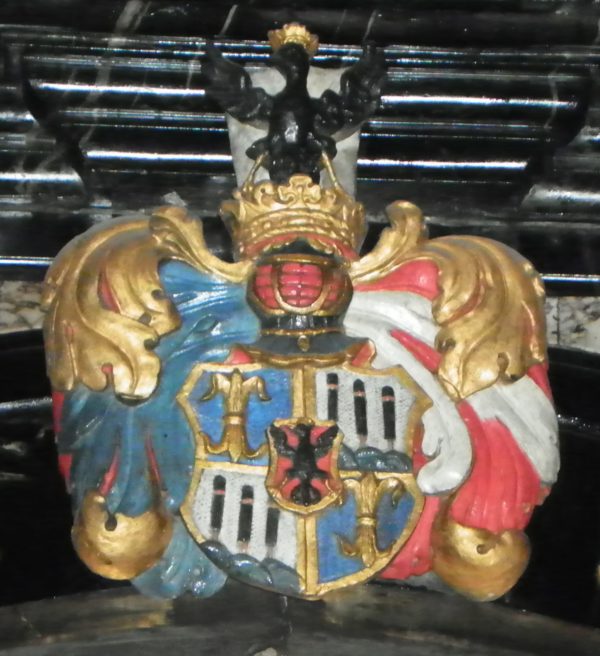
Coat of arms of the Zanetti family in Škofja Loka
ŠKOFJA LOKA, ST. JAMES' CHURCH
Location of the coat of arms: altar
The Zanetti family, originally from Venice, lived in Carniola in the seventeenth and eighteenth centuries. In the 1630s, one of its members, Antonio (died in 1691), the son of Bartolomeo and Nicolaia, settled as a merchant in the Škofja Loka (Germ. Bischoflack) area—more precisely in Suha (Germ. Suchen in Oberkrain)—and ran a lucrative trade between Carniola and Venice. In his own words, he brought 50,000 florins into the province every year to purchase various kinds of commodities and export them to his homeland. Not in the least impressed by Antonio and his family, other merchants in Škofja Loka, joined by the local governor, protested when Antonio’s son Bartolomeo/Bartholomäus (died in 1692) requested the status of Škofja Loka’s townsman, but to no avail.
The disgruntled local competition did little to stop the entrepreneurial Zanettis. For the family business to run as smoothly and effectively as possible, Antonio requested to be elevated to nobility. Noble status, among other things, entailed a legal change, freeing the newly ennobled townsmen from the town jurisdiction and transferring them under that of the provincial court for the nobility (Germ. Landschrannengericht). Most probably, that was also what Zanetti was hoping for. The emperor lent a sympathetic ear to his petition, even more willingly perhaps on the ground that the family’s lucrative business also benefited the imperial treasury by contributing 25,000 florins annually to its coffers. Granting Antonio’s request in 1661, he elevated him and his descendants to the rank of nobility of the Holy Roman Empire. Whether or not the Zanettis had already held some form of noble status (Venetian patriciate) prior to that is not entirely clear, but they were sometimes referred to as de Zanetti even before 1661. There is no doubt, however, that they used the coat of arms that the emperor improved that year by adding a black imperial lion to the heart-shaped escutcheon. The coat of arms also depicts staffs which the imperial office deemed so unusual that they asked the Zanettis for an explanation. Bartholomäus responded on behalf of his father, stating that they were “bastons,” without providing any further explanation regarding what they represented. Evidently satisfied with the answer, the imperial office translated the above-mentioned staffs in the Latin diploma as “baculi.” In the past, such staffs usually symbolized social and especially religious power, whereas in heraldry, they often represented a family branch not originating from the firstborn. Perhaps this was also the case of the Zanettis.
Over the following decades, the Zanetti family put down roots in Carniola and established a close-knit family network with the local, especially petty nobility. Franz Anton Zanetti (1661–1705), Bartholomäus’s oldest son, left a lasting mark on Škofja Loka. As the main heir, he inherited his father’s immovable property and (probably also) his business. He died relatively young and childless. The Altar of Corpus Christi in the local Church of St. James was completed at his behest about 1700. On that occasion, he most likely also had his family coat of arms mounted above the altar. The coat of arms can still be seen there today.
The Carniolan branch of the Zanetti family died out in the male line in the early nineteenth century, and the Viennese branch continued for another century.
Sources:
Preinfalk, Miha: Plemiške rodbine na Slovenskem. 17. stoletje. 1. del – Od Billichgrätzov do Zanettijev. Ljubljana: Viharnik, 2014, pp. 216–212.
